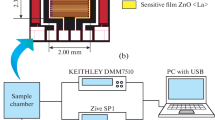Abstract
A thin film was coated onto the top of the heating electrodes to reduce the power consumption and improve the uniformity of temperature distribution. Finite element simulation software COMSOL was used to simulate the effect of coating materials and dependence of thicknesses of the coating film on the power consumption of the heating plate. On the basis of simulation, the temperature distribution of different heating plates was measured using infrared thermography. Experiments have showed that the power consumption of the heating plate can be significantly reduced and the temperature uniformity is promoted with adding the coating film on the top of the heating electrodes. The response of the gas sensor based on PdO-WO3 nanoparticles was characterized with analyte of acetone. It was found that the addition of the coating film could enhance the response to acetone. In addition, the response speed of sensors was investigated with coating films and the results indicated that with the coating film sensor response speed became faster.











Similar content being viewed by others
References
Fung SKH, Tang Z, Chan PCH et al (1996) Thermal analysis and design of a micro-hotplate for integrated gas-sensor applications. Sens Actuators A 54:482–487
Hua Z, Yuasa M, Kida T et al (2013) High sensitive gas sensor based on Pd-loaded WO3 nanolamellae. Thin Solid Films 548:677–682
Hwang WJ, Shin KS, Roh JH et al (2011) Development of micro-heaters with optimized temperature compensation design for gas sensors. Sensors 11:2580
Niranjan RS, Mulla IS (2003) Spin coated tin oxide: a highly sensitive hydrocarbon sensor. Mater Sci Eng B 103:103–107
Khan U, Falconi C (2013) Micro-hot-plates without simply connected hot-spots and with almost-circular temperature distribution. Sens Actuators B 185:274–281
Kim KJ, King WP (2009) Thermal conduction between a heated microcantilever and a surrounding air environment. Appl Therm Eng 29:1631–1641
Kumar SL, Vanathi PT, Kumar SL et al (2016) Modelling and simulation of low power polymer micro-heater for MEMS gas sensor applications. AJHSS 6:144
Lee DD, Chung WY, Choi MS et al (1996) Low-power micro gas sensor. Sens Actuators B 33:147–150
Li Y, Hua Z, Wu Y et al (2018) Modified impregnation synthesis of Ru-loaded WO3 nanoparticles for acetone sensing. Sens Actuators B 265:249–256
Liu Z, Liu B, Xie W et al (2016) Enhanced selective acetone sensing characteristics based on Co-doped WO3 hierarchical flower-like nanostructures assembled with nanoplates. Sens Actuators B 235:614–621
Maekawa T, Suzuki K, Takada T et al (2001) Odor identification using a SnO2-based sensor array. Sens Actuators B 80:51–58
Mahnke N, Markovic A, Duwensee H et al (2009) Numerically optimized shape of directly heated electrodes for minimal temperature gradients. Sens Actuators B 137:363–369
Peveler WJ, Binions R, Hailes SMV et al (2013) Detection of explosive markers using zeolite modified gas sensors. J Mater Chem A 1:2613–2620
Pike A, Gardner JW (1997) Thermal modeling and characterisation of micropower chemoresistive silicon sensors. Sens Actuators B 45:19–26
Prasad R, Kennedy LA, Ruckenstein E (1984) Catalytic Combustion. Chem Rev 26:1–58
Ray SC, Karanjai MK, Dasgupta D (1998) Tin dioxide based transparent semiconducting films deposited by the dip-coating technique. Surf Coat Tech 102:73–80
Resnik D, Vrtačnik D, Možek M et al (2011) Experimental study of heat-treated thin film Ti/Pt heater and temperature sensor properties on a Si microfluidic platform. J Micromech Microeng 21:025025
Simon I, Bârsan N, Bauer M et al (2001) Micromachined metal oxide gas sensors: opportunities to improve sensor performance. Sens Actuators B 73:1–26
Sun P, Jiang Y, Xie G et al (2009) A room temperature supramolecular-based quartz crystal microbalance (QCM) methane gas sensor. Sens Actuators B 141:104–108
Swaminathan P, Lavan DA, Weihs TP (2011) Dynamics of solidification in Al thin films measured using a nanocalorimeter. J Appl Phys 110:113519
Swart NR, Nathan A (1994) Design optimization of integrated microhotplates. Sens Actuators A 43:3–10
Tao C, Yin C, He M et al.(2008) Thermal analysis and design of a micro-hotplate for Si-substrated micro-structural gas sensor. In IEEE international conference on nano/micro engineered and molecular systems, Sanya, pp 284–287
Tiggelaar RM, Sanders RGP, Groenland AW et al (2009) Stability of thin platinum films implemented in high-temperature microdevices. Sens Actuators A 152:39–47
Wang P, Kong L, Wang X et al (2000) The design of a new integrated gas sensor array based on FEA. Sens Actuators B 66:66–69
Yu S, Wang S, Lu M et al (2017) A novel polyimide based micro heater with high temperature uniformity. Sens Actuators A 257:58–64
Zeng Y, Hua Z, Tian X et al (2017) modified impregnation synthesis of Fe-loaded WO3 nanosheets and the gas-sensing properties. Chem Lett 46:1353–1356
Zhang R, Gu Y, Zhu D et al (2002) Thermal measurement and analysis of micro hotplate array using thermography. Sens Actuators A 100:144–152
Zhou Q, Sussman A, Chang J et al (2015) Fast response integrated MEMS microheaters for ultra low power gas detection. Sens Actuators A 223:67–75
Acknowledgements
This study was supported by the Natural Science Foundation of Hebei (Grant NO. F2016202214), Hebei Province Foundation for Returned oversea scholars (Grant NO. CL201710), and National Natural Science Foundation of China (Grant NO. 61501167).
Author information
Authors and Affiliations
Corresponding author
Additional information
Publisher's Note
Springer Nature remains neutral with regard to jurisdictional claims in published maps and institutional affiliations.
Rights and permissions
About this article
Cite this article
Wu, Y., Yuan, L., Hua, Z. et al. Design and optimization of heating plate for metal oxide semiconductor gas sensor. Microsyst Technol 25, 3511–3519 (2019). https://doi.org/10.1007/s00542-019-04318-1
Received:
Accepted:
Published:
Issue Date:
DOI: https://doi.org/10.1007/s00542-019-04318-1




